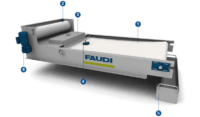An all-rounder for industry – structure and function of gravity filters
They are a particularly flexible talent for industry: gravity filters solve a range of filtration tasks in the treatment of all types of liquids, while minimising energy consumption. This is why they are valued in many branches of industry as an efficient and versatile filtration solution. But how do gravity filters work? How are they constructed? And what are the most typical areas of application? In this article, we explain how this all-rounder works and how you can use it to your advantage.
What are gravity filters used for?
Gravity filters are a particularly versatile type of filter that is primarily used to separate solids from liquids. The industrial applications are correspondingly numerous.
Metalworking industries primarily use gravity-based filters to separate metal particles from liquids, for example after grinding, turning or milling metal products.
Gravity filters are used in chemical production plants to remove impurities from chemicals and solvents. In the pharmaceutical and biotechnological sector, they can be used for the treatment of media, solutions and suspensions to remove microbial impurities.
The filters are also widely used in the food industry. They are used in breweries, wine and juice production plants, for example, to remove turbidity, yeast and other solids. Gravity filters are also used in dairies and to remove solids from fats, oils and broths.
Gravity filter systems are also used to purify drinking water and to treat waste water, demineralised water and purification and degreasing baths in various industrial sectors. This versatility makes them a popular type of filter. But what exactly makes them so multifunctional? How do gravity filters work and how are they constructed?
Our design as a gravity belt filter
Our gravity filter is an automatic gravity belt filter with a fibre fleece as the filter medium. Our filtration solution consists of a steel or stainless steel frame in which an endless carrier belt made of wire mesh is installed. This carrier belt is guided over a drive and deflection shaft with low wear and, together with the fibre fleece on top, forms a deep filter trough. The contaminated liquid flows smoothly into the filter trough via an inlet tray or an inlet box (3) with baffle plates.
Gravity causes the liquid to flow through the fibre fleece (1). Dirt particles are separated from the fibre fleece and a filter cake builds up. The build-up of the filter cake gradually reduces the flow rate.
As a result, the liquid level in the filter trough rises until the float switch (4) switches on the belt feed. The dirty fibre fleece is transported further by the drive motor (6) and discharged into the sludge box (5). At the same time, new fibre fleece is automatically drawn from the fleece roll (2) into the filter trough, the liquid level drops and the belt feed is stopped. The process then starts again in the gravity filter. The cleaned liquid is immediately available again for the machining process.
Depending on the selected size and filter medium, our belt filter achieves filtration capacities of up to 1,500 l/min. The FAUDI gravity filter therefore achieves high performance with good energy efficiency.

Are you looking for an effective solution for solids separation?
Find out all about our high-performance gravity belt filters for liquids in metalworking, wastewater treatment and other industrial processes.
Advantages of gravity (belt) filters
The mode of operation described above results in a number of advantages when using gravity filters – for example in terms of the economic efficiency and sustainability of production.
Utilising gravity as a “drive” for filtration is an energy-saving approach. With our solution, for example, energy is only used for the belt feed. This pays off in terms of cost-benefit efficiency.
The use of gravity filters also significantly extends the service life of process fluids. This saves costs for the disposal and procurement of new fluids and closes loops. This also pays off in terms of environmental compatibility.
A particular advantage of our FAUDI gravity belt filters is the automatic transport of the filter fleece as soon as the liquid flow through the filter cake becomes too low. This ensures continuous filtration. Our systems are also characterised by their particularly robust design, long service life and low maintenance requirements. This reduces potential downtimes and increases the cost-effectiveness of your investment.
Our filter systems are also not “off-the-shelf” solutions, but can be flexibly adapted to your requirements in terms of design and filtration performance. FAUDI gravity filters work both as stand-alone systems and as attachments for existing tanks. They are also available in steel or stainless steel versions. We will be happy to advise you on the right configuration for you.
Conclusion – the right setup for you
Gravity filters fulfil a variety of functions in industrial liquid treatment. They can be used in almost all industries where solids separation occurs. Gravity filters differ in design depending on the filtration task.
Thanks to its flexible design, our belt filter solution can be fully customised to your application. You determine the design and filtration performance – and we take care of everything from planning and engineering to maintenance. Contact us to find out more about our filter systems without obligation.



